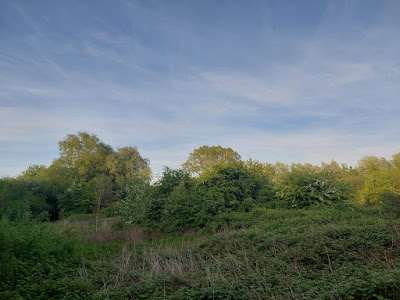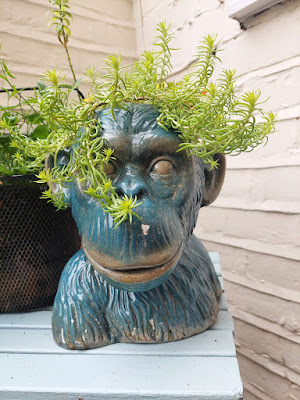Since last summer I've read four novels by Benjamin Myers, the four pictured above. Myers is a writer, author and journalist who has published fiction, non- fiction and poetry as well as writing for various magazines- NME, Melody Maker, Mojo, The Guardian, The Quietus, Time Out and more (he's also contributed to the excellent Weird Walk zine which I'll come back to another time in this series). He's from Durham and currently lives in the Calder Valley. Music forms a backdrop to or an intersection with a lot of his work and it was via music that I first encountered his writing.
The first of his books I read was The Perfect Golden Circle, a book I consumed from the sun lounger by the pool in Greece last July. It's a magical book, one of those completely self contained novels that you don't want to finish but can't stop reading. It's set in the hot summer of 1989, a summer where a series of crop circles appeared in fields across the south of England. Those crop circles are the work of two men, the classic odd couple, Redbone and Calvert (one a free party, peace convoy hippie- punk who lives in a van, the other an SAS veteran left reeling and scarred by the Falklands War). The two men plan and carry out the creation of crop circles through the summer, their work becoming more ambitious with every circle completed, building towards their moment of perfection- although according to Redbone the truly perfect circle does not exist, 'it can only exist as an idea'. The book feels like the summer of '89, but it goes wider and deeper, the novel a poetic reckoning with the English countryside, the history contained within it, English folk traditions, and the natural world. The Latin phrase Dum spiro spero (While I breathe, I hope) appears near the start of the story, tattooed on the arm of one of the two crop circle creators- both men in the novel are looking for something to keep them going, both living on the fringes of society, and finding something in an unexpected friendship and the crop circles that they've devoted themselves to.
In my mind crop circles are connected to The KLF- I'm pretty sure that Drummond and Cauty created one with their ghetto blaster and pyramid design at the centre.
What Time Is Love (Techno Scam Mix)
After The Perfect Golden Circle I read The Offing and enjoyed it just as much, another completely absorbing book with fully realised characters. The Offing is set in a summer not long after the end of the Second World War. Robert Appleyard, 16 years old, sets off on foot to find work, walking away from a Durham colliery village and coal mining, trying to find something, anything, that doesn't involve going underground. His journey takes him by chance to Dulcie Piper, a middle aged woman living alone in a ramshackle cottage, who takes him in, offering food and a bed in exchange for gardening toil. She also provides him with conversation, swear words and poetry, and encourages him to go to university. Dulcie's ex- lover, a German poet Romy Landau, becomes a presence and the story hinges around the circumstances of Romy's death and a manuscript of Romy's Robert discovers. The offing is the point where sea and sky merge on the horizon- the book is the story of a transition, of a place where two things meet (the two people of the tale and Robert's transition from childhood to the adult world), a summer where things change.
Last autumn I tackled The Gallows Pole. The characters from the novel (and history) were televised by Shane Meadows (who bought many of the cast of his This Is England series with him for The Gallows Pole). The Gallows Pole is historical fiction, based around the real life 'King' David Hartley of Cragg Vale (buried in Heptonstall churchyard, not far from Sylvia Plath's grave). In the late 18th century the Cragg Vale Coiners began counterfeiting coins, clipping the edges from the currency, melting the clippings and then producing their own counterfeit coins. They were so successful that they almost crashed the British economy. The coiners operated in an isolated world, West Yorkshire, where unemployment and threat of starvation were ever present. In Shane Meadows' dramatisation for TV there are meetings on the moor with men with stag's heads and a swirling psyche rock soundtrack from the likes of 70s rockers The Groundhogs and Swedish psyche band Goat. Hartley is portrayed as a hero, a man who has returned to save his community and be re- united with the woman he left behind. In Myers' novel Hartley is a much more dangerous character, violent and oppressive. The book switches between styles- narrative sections, chapters in the first person from Hartley's point of view (in prison awaiting trial) and from the view of Deighton, an official charged with bringing the group to justice, and from the viewpoint of James Broadbent, a coiner turned informant. It's a dense and epic tale, Myers bringing the late 1700s to life, a world where petty theft carried the death penalty, where the weather and the Yorkshire hills are a glowering presence, and where crime and community come together.
The Shining Levels, an alt- folk group from the north east of England, were so inspired by The Gallows Pole, that they wrote and recorded a soundtrack for the novel. The album marries folk and electronics, loops and synths and drones. This track, ghostly and slightly unnerving, opens the album...
Stag Dance
Goat's album that soundtracked Shane Meadows' BBC series came out on vinyl for Record Shop Day earlier this year. The digital version can be found here.
The fourth of Ben Myers' novels that I've read is Cuddy, a visionary telling of the story of St. Cuthbert, patron saint of the north of England, told over a thousand years. The story is as much about the north of England and the area around Durham, where Cuddy's remains are interred in a grave behind the altar in the cathedral. Cuddy's life in 7th century England took him from shepherd boy to monk, and life as a hermit on Lindisfarne. Attacks by Vikings led the monks at the monastery to move his remains, ending up in what would become Durham cathedral. Myers' book is split into four stories- it starts with the monks on the road with Cuddy's coffin, told by a devotee called Ediva, the text often breaking into chants and prayers. The second story moves to 1346 (the year before the Black Death arrived in England, something that struck Myers as relevant when writing in the summer of 2020 during Covid). Fletcher Bullard is home from war, an archer and domestic abuser. In Medieval Durham Bullard's wife meets Francis Rolfe, a stone mason working on the cathedral and things unravel. The third story jumps to the 19th century and an Oxford professor who has been invited to Durham to witness and record the opening of Cuthbert's tomb, a ghost story that brings the spectres of chanting monks into the 19th century. The fourth part of Cuddy is set in 2019, a young man caring for a dying mother and working in the 21st century, cash in hand, zero hours economy. He lands a job at Durham cathedral where he finds people and a place that he was excluded from previously, his eyes opened by the resting place of St. Cuthbert. As in The Perfect Golden Circle and The Offing, Cuddy is about land and nature, the elements, the north's history and the past impinging on the present as well as the characters Myers' creates. Cuddy is epic in scope and range, impressionistic in parts, poetic but also earthy and gritty, about real people and their lives.























